How to identify scam emails like "Mailbox Update"
Phishing/ScamAlso Known As: Mailbox Update phishing campaign
Get free scan and check if your device is infected.
Remove it nowTo use full-featured product, you have to purchase a license for Combo Cleaner. Seven days free trial available. Combo Cleaner is owned and operated by RCS LT, the parent company of PCRisk.com.
What kind of scam is "Mailbox Update"?
We have examined this email and found that it is a scam email disguised as a notification from an email service provider regarding a mailbox update. This scam email contains a link to a fake website designed to extract personal information. Anyone who receives this or a similar email should refrain from responding to it or providing details on presented sites.
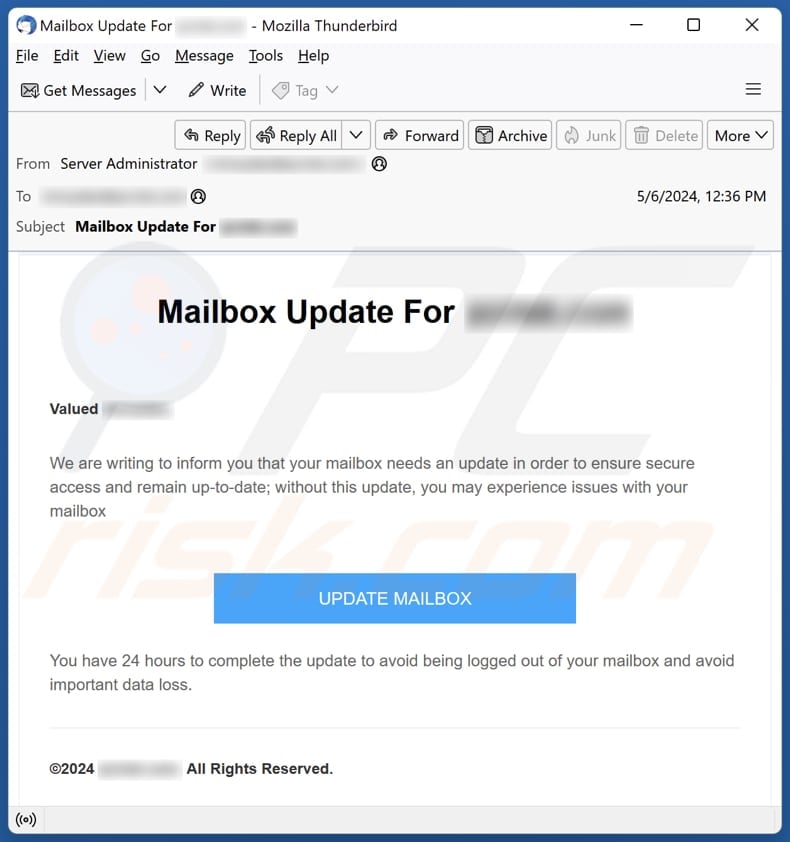
More about the "Mailbox Update" scam email
This email falls under the category of phishing scams. It informs the recipient that their mailbox requires an update for secure access. Also, the email urges the recipient to click on a link to update mailbox within 24 hours to prevent being logged out and losing important data.
Clicking the "UPDATE MAILBOX" button leads to a phishing website masquerading as an email account sign-in page. This site requests to provide an email address and password to continue (to sign in). The entered information is sent to scammers, who can misuse it for malicious purposes.
For example, scammers can use the accessed email account to send phishing emails to contacts, attempting to trick them into revealing personal information or downloading malware. Also, they may search the account for sensitive information. If the email account is linked to other online accounts, scammers may also try to access those accounts.
Additionally, if the compromised login credentials are used on multiple accounts, scammers may steal those accounts (e.g., social media, gaming, or banking accounts) and cause even more damage. Thus, it is important not to provide personal information on shady pages, especially those included in irrelevant or unexpected emails like the one described in our article.
| Name | Mailbox Update Scam |
| Threat Type | Phishing, Scam, Social Engineering, Fraud |
| Fake Claim | Recipient's mailbox requires an update for secure access |
| Disguise | Notification from an email service provider |
| Symptoms | Unauthorized online purchases, changed online account passwords, identity theft, illegal access of the computer. |
| Distribution methods | Deceptive emails, rogue online pop-up ads, search engine poisoning techniques, misspelled domains. |
| Damage | Loss of sensitive private information, monetary loss, identity theft. |
| Malware Removal (Windows) |
To eliminate possible malware infections, scan your computer with legitimate antivirus software. Our security researchers recommend using Combo Cleaner. Download Combo CleanerTo use full-featured product, you have to purchase a license for Combo Cleaner. 7 days free trial available. Combo Cleaner is owned and operated by RCS LT, the parent company of PCRisk.com. |
Similar scam emails in general
Phishing emails often mimic legitimate organizations or individuals and include links or attachments. Also, they use urgent language to trick recipients into acting quickly (without taking time to examine the email). Overall, phishing emails rely on deception and social engineering tactics.
Examples of similar scams are "Wells Fargo - Account Verification Required", "Request To Cancel Your Services", and "Your Password Changed". Users should be aware that links and attachments can be employed to deliver malware.
How do spam campaigns infect computers?
Typically, when cybercriminals use email to distribute malware, they send emails containing malicious attachments or links. Their goal is to trick recipients into executing malware via those files or links. Malware can infiltrate computers upon opening malicious executables, enabling macros in malicious MS Office documents, or performing similar actions.
Clicking malicious links received via email can lead to opening websites hosting malware. These sites can be designed to automatically download malicious files or apps or use deception to lure visitors into downloading and executing malware by themselves.
How to avoid installation of malware?
Download applications and files from trustworthy (official) websites and app stores. Examine emails before opening links or attachments, especially when they are unexpected and (or) sent from unknown addresses. Avoid clicking ads, pop-ups, download buttons, or warnings on questionable websites. Regularly update the operating system and software.
Also, use reputable security solution and scan your computer for unwanted apps. Never download pirated software or tools designed to bypass software activation. If you have already opened malicious attachments, we recommend running a scan with Combo Cleaner Antivirus for Windows to automatically eliminate infiltrated malware.
Text presented in the "Mailbox Update" email letter:
Subject: Mailbox Update For ********
Mailbox Update For ********
Valued ********,
We are writing to inform you that your mailbox needs an update in order to ensure secure access and remain up-to-date; without this update, you may experience issues with your mailboxUpdate Mailbox
You have 24 hours to complete the update to avoid being logged out of your mailbox and avoid important data loss.
©2024 ********. All Rights Reserved.
Phishing website presented in this email:
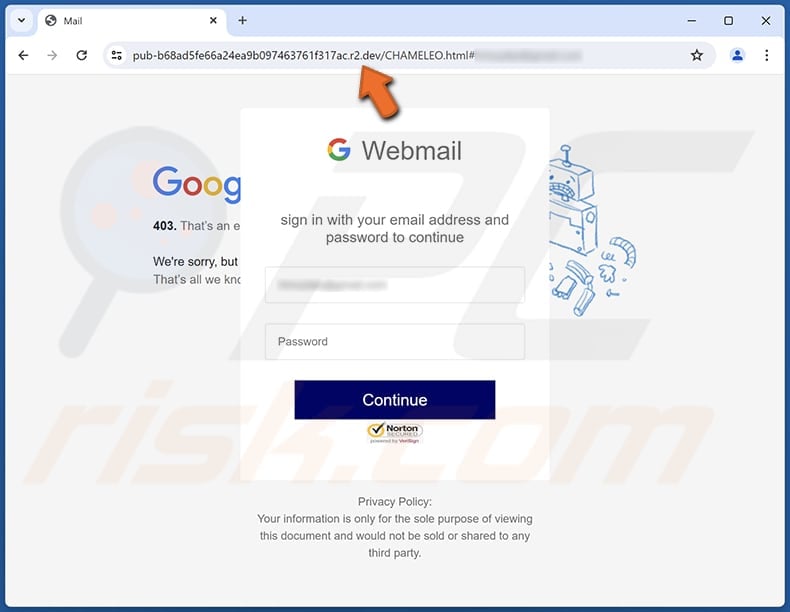
Other examples of mailbox update-themed spam emails:
Sample 1:
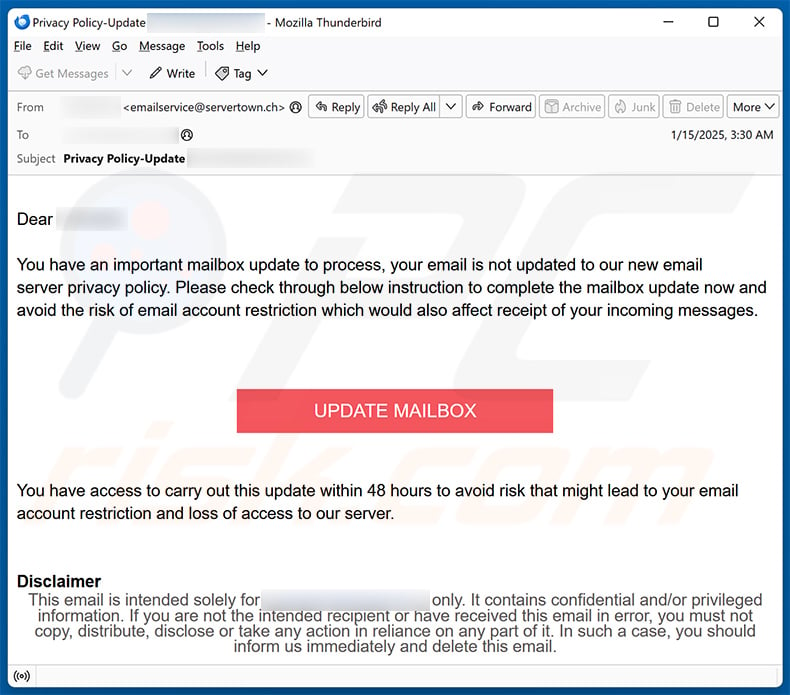
Text presented within:
Subject: Privacy Policy-Update ********
Dear ********You have an important mailbox update to process, your email is not updated to our new email server privacy policy. Please check through below instruction to complete the mailbox update now and avoid the risk of email account restriction which would also affect receipt of your incoming messages.
Update MailboxYou have access to carry out this update within 48 hours to avoid risk that might lead to your email account restriction and loss of access to our server.
Disclaimer
This email is intended solely for ******** only. It contains confidential and/or privileged information. If you are not the intended recipient or have received this email in error, you must not copy, distribute, disclose or take any action in reliance on any part of it. In such a case, you should inform us immediately and delete this email.
******** Administrator Services. All Rights Reserved
Sample 2:
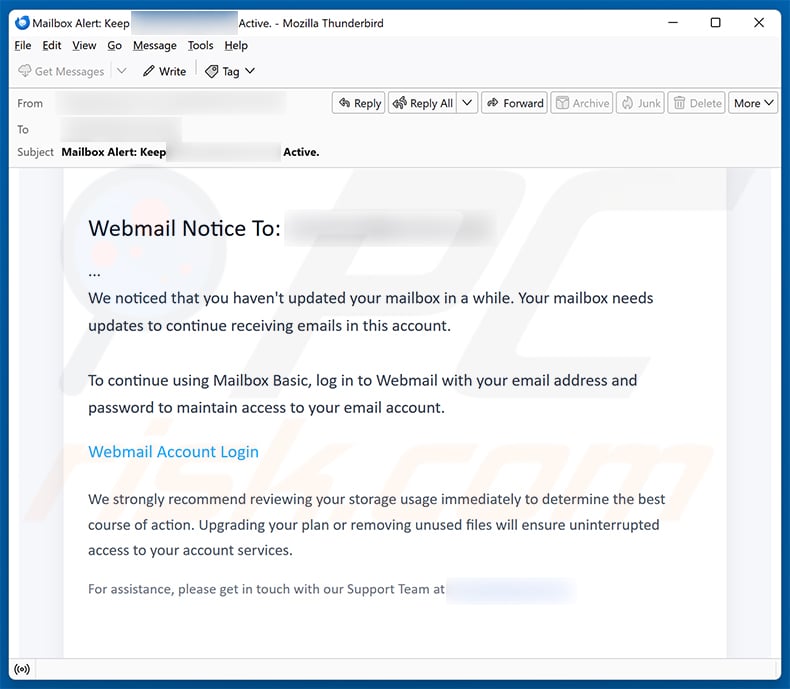
Text presented within:
Subject: Mailbox Alert: Keep ******** Active.
Secure Message256-bit SSL • PCI-DSS Compliant •
Webmail Notice To: ********...
We noticed that you haven't updated your mailbox in a while. Your mailbox needs updates to continue receiving emails in this account.To continue using Mailbox Basic, log in to Webmail with your email address and password to maintain access to your email account.
Webmail Account LoginWe strongly recommend reviewing your storage usage immediately to determine the best course of action. Upgrading your plan or removing unused files will ensure uninterrupted access to your account services.
For assistance, please get in touch with our Support Team at ********
© ********, All rights reserved.
Screenshot of the promoted phishing site:
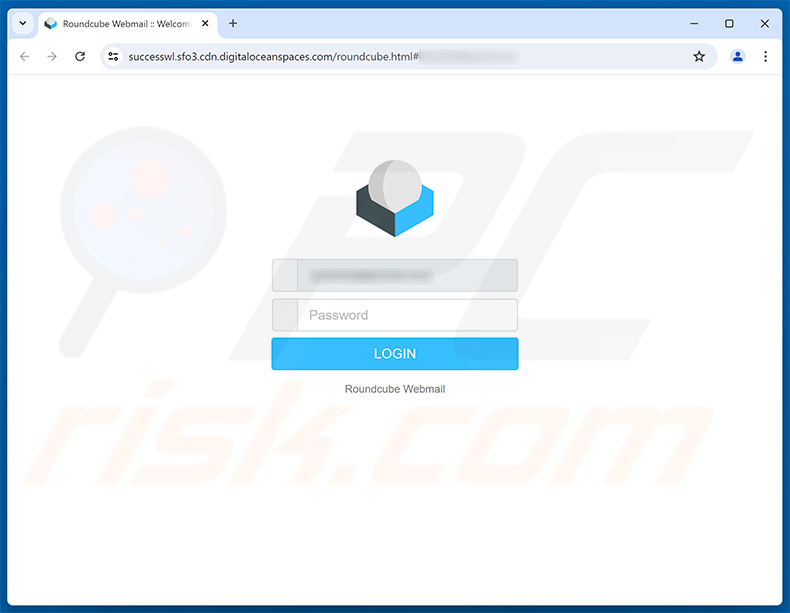
Instant automatic malware removal:
Manual threat removal might be a lengthy and complicated process that requires advanced IT skills. Combo Cleaner is a professional automatic malware removal tool that is recommended to get rid of malware. Download it by clicking the button below:
DOWNLOAD Combo CleanerBy downloading any software listed on this website you agree to our Privacy Policy and Terms of Use. To use full-featured product, you have to purchase a license for Combo Cleaner. 7 days free trial available. Combo Cleaner is owned and operated by RCS LT, the parent company of PCRisk.com.
Quick menu:
- What is Mailbox Update phishing campaign?
- Types of malicious emails.
- How to spot a malicious email?
- What to do if you fell for an email scam?
Types of malicious emails:
![]() Phishing Emails
Phishing Emails
Most commonly, cybercriminals use deceptive emails to trick Internet users into giving away their sensitive private information, for example, login information for various online services, email accounts, or online banking information.
Such attacks are called phishing. In a phishing attack, cybercriminals usually send an email message with some popular service logo (for example, Microsoft, DHL, Amazon, Netflix), create urgency (wrong shipping address, expired password, etc.), and place a link which they hope their potential victims will click on.
After clicking the link presented in such email message, victims are redirected to a fake website that looks identical or extremely similar to the original one. Victims are then asked to enter their password, credit card details, or some other information that gets stolen by cybercriminals.
![]() Emails with Malicious Attachments
Emails with Malicious Attachments
Another popular attack vector is email spam with malicious attachments that infect users' computers with malware. Malicious attachments usually carry trojans that are capable of stealing passwords, banking information, and other sensitive information.
In such attacks, cybercriminals' main goal is to trick their potential victims into opening an infected email attachment. To achieve this goal, email messages usually talk about recently received invoices, faxes, or voice messages.
If a potential victim falls for the lure and opens the attachment, their computers get infected, and cybercriminals can collect a lot of sensitive information.
While it's a more complicated method to steal personal information (spam filters and antivirus programs usually detect such attempts), if successful, cybercriminals can get a much wider array of data and can collect information for a long period of time.
![]() Sextortion Emails
Sextortion Emails
This is a type of phishing. In this case, users receive an email claiming that a cybercriminal could access the webcam of the potential victim and has a video recording of one's masturbation.
To get rid of the video, victims are asked to pay a ransom (usually using Bitcoin or another cryptocurrency). Nevertheless, all of these claims are false - users who receive such emails should ignore and delete them.
How to spot a malicious email?
While cyber criminals try to make their lure emails look trustworthy, here are some things that you should look for when trying to spot a phishing email:
- Check the sender's ("from") email address: Hover your mouse over the "from" address and check if it's legitimate. For example, if you received an email from Microsoft, be sure to check if the email address is @microsoft.com and not something suspicious like @m1crosoft.com, @microsfot.com, @account-security-noreply.com, etc.
- Check for generic greetings: If the greeting in the email is "Dear user", "Dear @youremail.com", "Dear valued customer", this should raise suspiciousness. Most commonly, companies call you by your name. Lack of this information could signal a phishing attempt.
- Check the links in the email: Hover your mouse over the link presented in the email, if the link that appears seems suspicious, don't click it. For example, if you received an email from Microsoft and the link in the email shows that it will go to firebasestorage.googleapis.com/v0... you shouldn't trust it. It's best not to click any links in the emails but to visit the company website that sent you the email in the first place.
- Don't blindly trust email attachments: Most commonly, legitimate companies will ask you to log in to their website and to view any documents there; if you received an email with an attachment, it's a good idea to scan it with an antivirus application. Infected email attachments are a common attack vector used by cybercriminals.
To minimise the risk of opening phishing and malicious emails we recommend using Combo Cleaner Antivirus for Windows.
Example of a spam email:

What to do if you fell for an email scam?
- If you clicked on a link in a phishing email and entered your password - be sure to change your password as soon as possible. Usually, cybercriminals collect stolen credentials and then sell them to other groups that use them for malicious purposes. If you change your password in a timely manner, there's a chance that criminals won't have enough time to do any damage.
- If you entered your credit card information - contact your bank as soon as possible and explain the situation. There's a good chance that you will need to cancel your compromised credit card and get a new one.
- If you see any signs of identity theft - you should immediately contact the Federal Trade Commission. This institution will collect information about your situation and create a personal recovery plan.
- If you opened a malicious attachment - your computer is probably infected, you should scan it with a reputable antivirus application. For this purpose, we recommend using Combo Cleaner Antivirus for Windows.
- Help other Internet users - report phishing emails to Anti-Phishing Working Group, FBI’s Internet Crime Complaint Center, National Fraud Information Center and U.S. Department of Justice.
Frequently Asked Questions (FAQ)
Why did I receive this email?
Usually, phishing emails are sent out indiscriminately to large numbers of addresses (they are not personal). Scammers obtain email addresses from data breaches, unreliable pages where these emails were provided by users, or in similar ways.
I have provided my personal information when tricked by this email, what should I do?
Change your email account password as soon as possible and inform your email service provider about the phishing attack. If you suspect that your password may be used to access other accounts, change the passwords for those accounts.
I have downloaded and opened a malicious file attached to an email, is my computer infected?
Typically, malicious executables introduce malware upon execution. Other files, such as MS Office documents, often necessitate additional actions like enabling macro commands to initiate malicious activities. Thus, whether your computer is infected or not depends on the file you opened.
I have read the email but did not open the attachment, is my computer infected?
It is safe to open an email without clicking links or opening attached files. Thus, your computer is not infected, even if the email contains malicious files or links.
Will Combo Cleaner remove malware infections that were present in email attachment?
Yes, Combo Cleaner can find and eliminate most known malware. High-end malware usually hides deep in the system. Thus, running a full system scan is required to remove malware of this kind.
Share:

Tomas Meskauskas
Expert security researcher, professional malware analyst
I am passionate about computer security and technology. I have an experience of over 10 years working in various companies related to computer technical issue solving and Internet security. I have been working as an author and editor for pcrisk.com since 2010. Follow me on Twitter and LinkedIn to stay informed about the latest online security threats.
PCrisk security portal is brought by a company RCS LT.
Joined forces of security researchers help educate computer users about the latest online security threats. More information about the company RCS LT.
Our malware removal guides are free. However, if you want to support us you can send us a donation.
DonatePCrisk security portal is brought by a company RCS LT.
Joined forces of security researchers help educate computer users about the latest online security threats. More information about the company RCS LT.
Our malware removal guides are free. However, if you want to support us you can send us a donation.
Donate
▼ Show Discussion